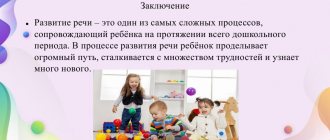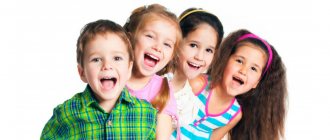Creating a developmental environment
In order for a child’s speech to develop, it is necessary to create favorable conditions for this. The most important thing is to talk to the child as much as possible, because speech is based on imitation - repeating words and phrases after an adult. Speech should constantly surround the baby; he should “bathe” in speech. To do this, the adult comments on all everyday situations, routine moments and other events in the baby’s life.
For example, washing: “Let’s go wash. Let's open the tap. No, not this way, the other way. Like this. Where's the soap? Here's the soap. Take soap and wash your hands. Put the soap in the soap dish. Let me help you. Three hands good. Now let's wash off the soap. Place your hands under the water - like this. Now let's wash our face. Take water into your palms and rub your face. Close the tap. Now let's shake the water off our hands - like this. Where's the towel? Take a towel and dry your face and hands. Well done! Look how clean it has become.”
Perhaps such a constant conversation with the baby will initially cause some difficulties for adults and will require a change in communication style and behavior. But as experience shows, this is a matter of training: if there is a desire and enough persistence, then an adult can, over time, learn to communicate with the baby more constructively from the point of view of the child’s speech development. At the same time, with experience comes a “sense of balance”: you need to speak constantly, but at the same time not overdo it and not be too verbose, speak with normal volume, simple phrases and only to the point.
Development of active speech in a child under 3 years of age
Of course, all parents want their child to speak as quickly as possible, so that his speech is clear and correct. By developing a child’s active speech, we first of all stimulate his speech imitation.
Speech imitation is the reproduction after the speaker of the sounds, words, and phrases he pronounces. Speech imitation of a small child at first looks like an echo: an adult speaks and the child immediately repeats. Over time, the possibility of time-delayed repetition appears. For a child’s imitation of an adult’s speech to be meaningful, the speech must be closely related to the child’s practical activities. According to physiologists, imitation in humans is an unconditioned reflex, that is, an innate skill. The baby, without realizing it, adopts the speech that he hears from the lips of others.
If a child’s speech develops with a delay, it is necessary to carry out special work to activate the need to imitate the words of an adult. At the same time, the child’s attempts to speak are accepted in any form, even if he speaks incomprehensibly and distorted.
It is better to develop speech imitation in interesting games. For example, we run around the room with our arms spread out to the sides - we are “airplanes”, we fly and buzz “Oooh!”; or we walk around the room and “turn the steering wheel” - we are “cars”, we drive and signal “Beep!”; We pretend to play the pipe - “Doo-doo-doo!”; or we put the doll to sleep and sing her the song “Bay-bye!”
Particularly effective for speech development is the technique of finishing words in familiar nursery rhymes and poems. To do this, we pause, asking the child to finish the last word in a line of poetry or a whole line. For example:
Birdie... (birdie), Here's some... (water)! Here you have... (crumbs) On my... (palm)!
Cockerel, cockerel... (Golden comb) Look out the window... (I'll give you some peas!)
In addition, it is necessary to carry out special work on the development of the child’s verbal dictionary, taking into account the following pattern: the more words - names of actions in the child’s speech, the higher the level of development of his speech! When developing a child’s verbal vocabulary, first use lighter versions of words: “top-top” - goes, “kach-kach” - swings on a swing, “am-am” - eats, “kup-kup” - bathes, “boom” - fell and etc. To make it more interesting for the child to study, you can select photographs of the child himself and his family members, in which they perform some simple, recognizable actions.
Of course, it is better to work on the development of active speech using visual aids - objects, toys and pictures.
How to determine the level of speech development of a baby?
Most modern parents are aware of the importance of developing a child's speech and jealously monitor how their baby speaks. This is manifested primarily by comparing the child’s speech development level with the way his peers speak. It’s great if the baby speaks willingly and quite intelligibly. But if a child speaks very little, is so unintelligible that it is impossible to understand him, or is completely silent, this seriously worries his loved ones.
However, to determine the level of development of a child’s speech, it is not enough to compare his speech with the way his peers speak. To determine whether a child’s speech corresponds to age standards, tables of the dynamics of speech development are used. This kind of information is in the public domain and gives a general idea of the stages of speech formation in a child - in what periods humming, babbling, first words and phrases appear, how his passive gradually develops (what the child understands, but does not yet speak himself) and active vocabulary (what the child understands and uses in his own speech). By carefully testing your child's speech, you can identify gaps in its development.
Speech development classes with a child per year
Taking an active position regarding the development of their baby’s speech, parents, in addition to rich verbal communication, should organize regular classes on the development of the child’s speech.
Of course, this will require special training and new knowledge. In the development of a child’s speech, two main directions can be distinguished - the development of understanding of speech and the development of the child’s own active speech. In addition, it is necessary to pay enough attention to such additional areas of work as the development of breathing and hearing, imitation and fine motor skills.
Please note that classes on speech development are not only useful, but necessary for all children - both normally developing (in this case, such classes will stimulate all aspects of the baby’s development), and children who have a delay in speech development (in this case, it is possible successfully compensate for the delay before the child reaches the age of four), as well as for children with speech therapy problems that are systemic in nature - general speech underdevelopment, etc. (in this case, at an early age you can study according to the system described here, and in the future organize special classes with speech therapist).
How to determine the dynamics of a baby’s speech development?
It is necessary to warn that the results of speech work with a child do not always appear quickly. Don't worry and be patient - often the baby needs a period of accumulation of new knowledge and skills before he begins to actively use them. But in order to still see the dynamics of the child’s speech development, you can keep a “Speech Development Diary”, in which you not only enter new words and phrases that appear in the baby’s speech, but also the dates of their appearance. Having looked through the records for several months, you can clearly see the results of your joint work with your baby.
Good luck with your baby’s speech development!



